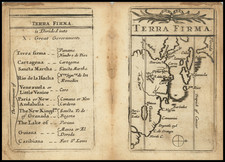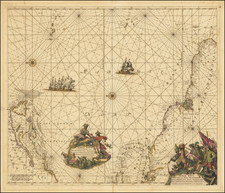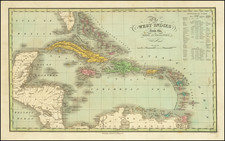Fine Hand Drawn Spanish Military Map Depicting the Fortifications around New Port Royal During The Spanish Siege of Roatan in March 1782.
This finely executed map depicts the English fortifications and tpographical features around New Port Royal, at the Southwest part of the Island, at the time of the Spanish Attack on the Island of Roatan, under the command of Guatemalan Governor Don Mathias de Galves, in March 1782.
The two primary ships of the Spanish Royal Navy engaged in the battle, the Santa Matilda and the Santa Cecilia, are located. The map also includes coastal features, soundings, navigational hazards, anchorages, fortifications, houses, and a settlement; along with a heavily fortified position on a small island in the harbor, comprising houses which served as a gunpowder store and a limehouse. The key at the bottom left identifies the English positions, cannons and batteries.
The map focuses on the heavily fortified town and harbor of New Port Royal, location of the principal British Fortifications and Defenses and the positions of the Spanish Royal Navy during the Battle of Roatan. The main entrance to the port is marked 'G' between two rocky reefs, where the depth of water and sand is sufficient for any type of vessel to pass through safely, and other entrance channels are marked, together with sandbanks, beaches and rocks to be avoided.
The Battle of Roatán was an American War of Independence battle fought on March 16, 1782, between British and Spanish forces for control of Roatán, an island off the Caribbean coast of present-day Honduras. Following the British defeat at Yorktown, the theater of war increasingly focused on the Caribbean.
The Spanish forces were led by Guatemalan Governor, Matías de Gálvez. Gálvez' plans called for assaults on the British presence in the Bay Islands (principally Roatán), followed by a sweep along the coast to eliminate the British from the mainland. Troops from central Guatemala were staged in early 1782 at Trujillo, for the assault on Roatán, while additional forces moved overland from Nicaragua, Honduras, and Salvador toward the principal British settlement of Black River.
Gálvez arrived at Trujillo on March 8, to organize the assault on Roatán. Leaving a force of 600 at Trujillo to further harass the British and their partisan allies, he took another 600 troops onto transports, and sailed for Roatán on March 12, escorted by three frigates ( Santa Matilde, the Santa Cecilia, and the Antiope) and a number of smaller armed naval vessels, under the command of Commodore Enrique Macdonell.
The British residents of Roatán were aware of the ongoing Spanish military activities. The main settlement, New Port Royal, was defended by Forts Dalling and Despard, which mounted 20 guns. The island's white non-slave population was however quite small. In 1781, they appealed to the British commander at Bluefields for support, but he was only able to send additional weapons, which did not add significantly to the island's defenses.
The Spanish fleet arrived off Roatán early on March 13, 1782, and anchored out of range, while Gálvez sent a party in to request the surrender of the island's defenders. The British asked for six hours to consider their options, which Gálvez granted. After that time had elapsed, the British refused to surrender. Immediate attack was not possible due to high winds and rough seas, so Gálvez then held council, and a plan of attack was formulated.
At about 10:15 am on March 16, Spanish guns opened up against Forts Dalling and Despard, which guarded the mouth of New Port Royal's harbor. By 1:00 pm the British guns there had been silenced, and Major General Gabriel Herbias began landing troops. After the two forts were secured, the Spanish warships entered the harbor and began raking the town with cannon fire, while British artillery fired back from positions in the hills above the town. This exchange continued until sunset, at which point the British capitulated. The Spanish had two killed and four wounded in the battle, while only two slaves were wounded on the other side.
Gálvez was able to only temporarily and partially eliminate British influences in the area. He followed up his success at Roatán with the capture of Black River in early April 1782, but attempt to advances failed. James Lawrie, the commander at Black River, and Edward Marcus Despard, successfully recaptured Black River, and were able to hold it until the end of the war.
The Library of Congress holds a similar manuscript map: https://www.loc.gov/item/90683592/
Roatan History
Roatan was visited by Christopher Columbus on his fourth voyage (1502-1504), as he visited the neighboring Bay Island of Guanaja. Soon after the Spanish began raiding the islands for slave labor and they later became a pirate haven.
Throughout European colonial times, the Bay of Honduras attracted an array of individual settlers, pirates, traders and military forces. Various economic activities were engaged in and political struggles played out between the European powers, chiefly Britain and Spain. Sea travellers frequently stopped over at Roatán and the other islands as resting points. On several occasions, the islands were subject to military occupation. In contesting with the Spanish for colonization of the Caribbean, the English occupied the Bay Islands on and off between 1550 and 1700. During this time, prirate found the vacated, mostly unprotected islands a haven for safe harbor and transport. English, French and Dutch pirates established settlements on the islands. They frequently raided the Spanish treasure and cargo vessels carrying gold and silver from the New World to Spain.
In 1797, the British defeated the Black Carib, who had been supported by the French, in a battle for control of the Windward Caribbean island of St. Vincent. Weary of their resistance to British plans for sugar plantations, the British rounded up the St. Vincent Black Carib and deported them to Roatán. The majority of Black Carib migrated to Trujillo on mainland Honduras, but a portion remained to found the community of Punta Gorda on the northern coast of Roatán. The Black Carib, whose ancestry includes Arawak and African Maroons, remained in Punta Gorda, becoming the Bay Island's first permanent post-Columbian settlers. They also migrated from there to parts of the northern coast of Central America, becoming the foundation of the modern-day Garífuna culture in Honduras, Belize and Guatemala.













![Culiacanae, Americae Regionis, Descriptio [with] Hispaniolae, Cubae, Aliarumqe Insualrum Circumiacientium Delineatio](https://storage.googleapis.com/raremaps/img/small/86114.jpg)
![[ English Plantations in North America ] A New Map of the most Considerable Plantations of the English In America Dedicated to His Highness William Duke of Glocester.](https://storage.googleapis.com/raremaps/img/small/98233.jpg)